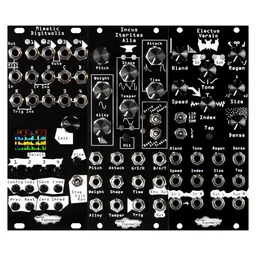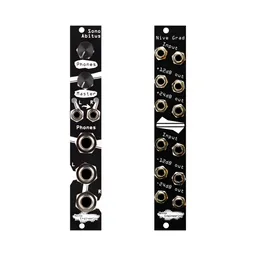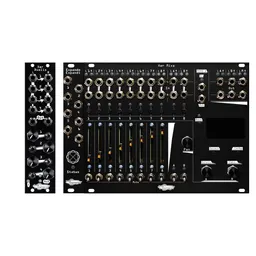The type of jack and cable you use for audio connections can be very important. Often, it just won’t fit in a plug, but there are a few types of jacks that fit the same footprint but function very differently. Let’s go over one of the most common that has a variety of incompatible uses: TRS.
Some backstory: what is TRS in the first place?
⅛” (or 3.5 mm to the metrically inclined) and ¼” jacks are named by how many segments they have. Take a look at a standard Eurorack patch cable: that’s a TS, or Tip Sleeve, connector. An AUX cord, however, is a common type of ⅛” TRS, or Tip Ring Sleeve, connector. You’ll notice the TS plug has two separate segments on it, and an AUX cord has 3. We use TS cables in Eurorack because all audio/CV that we pass through a patch cable is mono. One section carries the voltage, the other is ground. On a TRS cable, we can send two separate signals: for instance, left and right audio in an AUX cable.

So what about TRS? Let’s talk headphones.
The most common place in Eurorack to find a TRS jack is on headphone outputs. This brings us to our first use of TRS cables: stereo audio. Headphones are stereo, so the extra channel gives us separate left and right signals.
TRS connectors are always stereo, right?

The beautiful XLR (photo credit: Wikipedia)
Nope! Especially not in pro audio. In fact, you’ll basically never see a stereo connector on a piece of professional audio equipment that’s not a headphone output. This is because a lot of pro audio equipment is designed to use what’s called balanced audio. Balanced audio uses TRS connectors (or sometimes XLR: see the picture). The difference, though, is that the signal is mono: one channel is the original signal, and the other is a phase-inverted copy. Balanced audio is designed to reduce noise caused by electromagnetic interference on long cable runs, so if you’re designing a big studio or running a 30-foot cable, you’ll probably want it to be balanced. For short connections, though, it generally doesn’t make a difference (I’m a pretty big audio snob and still do all my synth recording with unbalanced connections).
Cancel that!
Have you ever plugged a cable in and discovered that no matter what you did, you got no output? We’re not spying on you. Maybe you did something else entirely… but here’s a simple thing that goes wrong when we don’t think about what we’re doing or when we don’t understand how balanced and unbalanced signals work.
Remember that balanced audio works by using phase cancellation, so it expects inverted signals in the two channels. If it instead receives just a stereo (i.e., more or less replicated) signal, those signals cancel each other out. Net result? Silence.

Phase cancellation!
Wait, does that mean I can’t plug an unbalanced signal into a balanced input (like the one on my audio interface)??
Actually, you totally can! Obviously, if your output is not balanced you won’t have any of the advantages of a balanced cable run. But as long as your signal is mono, plugging an unbalanced signal into a balanced connector will work just fine. A topical example: the inputs on my audio interface are balanced, but all the connections on my Eurorack system aren’t. I generally record direct from the voices in my system just by plugging their outputs into my interface with ⅛” to ¼” adapters.
Another place we sometimes see TRS connections: MIDI
A recent trend that’s becoming more and more common is to run MIDI from an ⅛” jack. This also uses a TRS jack, but obviously, does not produce any musical sound, just MIDI data.
Moral of the story: RTFM to make sure you're using the right kind of cable for your stuff
Any piece of audio equipment should have a manual, and that manual should specify what it’s looking for on its inputs and outputs. It’s always worth double-checking everything so you don’t run into problems down the road (or right away when you have no sound). For instance: my Elektron Analog Four MKII has a number of ¼” connectors on the back, but since they all do different things (individual channel outs, CV/gate, etc), the type of connector they need varies a bit. Reading the manual taught me some new things about one of my favorite polysynths, but more importantly helped me get everything hooked up correctly and working great on the first try.






